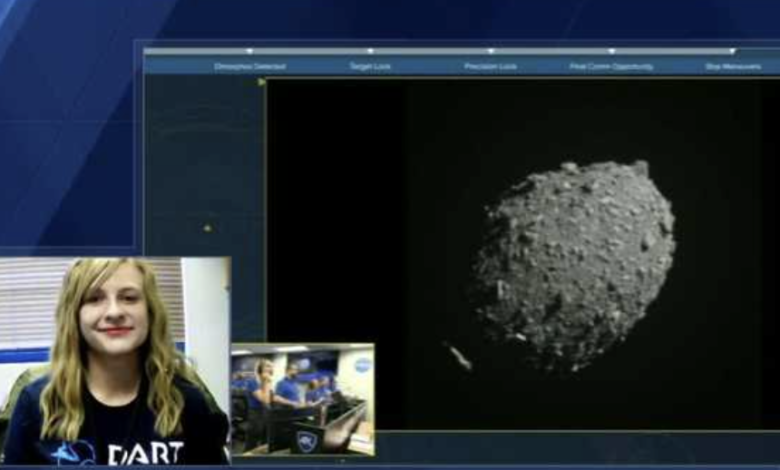

NASA on Monday conducted the first ever mission to intentionally crash a spacecraft into an asteroid.Watch the video above to see what Elizabeth Gabeler, who was on the team that helped design the Dart spacecraft, had to say about itThe mission was part of a long-term goal of being ready to handle the threat — while not imminent or likely — of a large asteroid hitting Earth. The $325 million mission was the first attempt to shift the position of an asteroid or any other natural object in space.The galactic grand slam occurred at a harmless asteroid 7 million miles away, with the spacecraft named Dart plowing into the small space rock at 14,000 mph. Scientists expected the impact to carve out a crater, hurl streams of rocks and dirt into space and, most importantly, alter the asteroid’s orbit.Monday’s target: a 525-foot asteroid named Dimorphos. It’s actually a moonlet of Didymos, Greek for twin, a fast-spinning asteroid five times bigger that flung off the material that formed the junior partner.The pair have been orbiting the sun for eons without threatening Earth, making them ideal save-the-world test candidates.Launched last November, the vending machine-size Dart — short for Double Asteroid Redirection Test — navigated to its target using new technology developed by Johns Hopkins University’s Applied Physics Laboratory, the spacecraft builder and mission manager.Dart’s on-board camera, a key part of this smart navigation system, caught sight of Dimorphos barely an hour before impact.
NASA on Monday conducted the first ever mission to intentionally crash a spacecraft into an asteroid.
Watch the video above to see what Elizabeth Gabeler, who was on the team that helped design the Dart spacecraft, had to say about it
The mission was part of a long-term goal of being ready to handle the threat — while not imminent or likely — of a large asteroid hitting Earth. The $325 million mission was the first attempt to shift the position of an asteroid or any other natural object in space.
The galactic grand slam occurred at a harmless asteroid 7 million miles away, with the spacecraft named Dart plowing into the small space rock at 14,000 mph. Scientists expected the impact to carve out a crater, hurl streams of rocks and dirt into space and, most importantly, alter the asteroid’s orbit.
Monday’s target: a 525-foot asteroid named Dimorphos. It’s actually a moonlet of Didymos, Greek for twin, a fast-spinning asteroid five times bigger that flung off the material that formed the junior partner.
The pair have been orbiting the sun for eons without threatening Earth, making them ideal save-the-world test candidates.
Launched last November, the vending machine-size Dart — short for Double Asteroid Redirection Test — navigated to its target using new technology developed by Johns Hopkins University’s Applied Physics Laboratory, the spacecraft builder and mission manager.
Dart’s on-board camera, a key part of this smart navigation system, caught sight of Dimorphos barely an hour before impact.
Source link








